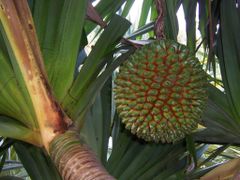Pandanus
2007 Schools Wikipedia Selection. Related subjects: Plants
| iPandanus | ||||||||||||
|---|---|---|---|---|---|---|---|---|---|---|---|---|
 Fruit of Pandanus utilis
|
||||||||||||
| Scientific classification | ||||||||||||
|
||||||||||||
|
|
||||||||||||
|
See text |
Pandanus is a large genus of between 600-700 species of tree- or shrub-like flowering plants in the family Pandanaceae. The genus is native to the Old World tropics and western Pacific Ocean islands, with the largest number of species in Madagascar and Malesia (Wagner, Herbst, & Sohmer 1990). They are typically found in lower forested areas, savanahs, and along wetter shoreline regions. They are sometimes called screwpines because their long, flat leaves grow in a spiral pattern.
They vary in size from small shrubs less than 1 m tall, up to medium-sized trees 20 m tall, typically with a broad canopy and moderate growth rate. The trunk is stout, wide-branching, and ringed with many leaf scars. They commonly have many thick prop roots near the base, which provide support as the tree grows top-heavy with leaves, fruit, and branches. The leaves are strap-shaped, varying between species from 30 cm up to 2 m or more long, and from 1.5 cm up to 10 cm broad.
They are dioecious, with male and female flowers produced on different plants. The flowers of the male tree are 2-3 cm long and fragrant, surrounded by narrow, white bracts. The female tree produces flowers with round fruits that are also bract-surrounded. The fruits are globose, 10 to 20 cm in diameter, and have many prism-like sections, resembling the fruit of the pineapple. Typically, the fruit changes from green to bright orange or red as it matures. The fruit is edible.
- Selected species
|
|
Cultivation and uses
Pandan ( P. amaryllifolius) leaves are used in Southeast Asian cooking to add a distinct aroma to rice and curry dishes such as nasi lemak, kaya preserves, and desserts such as pandan cake. They are known as daun pandan in Malay and 斑蘭 [bān lán] in Mandarin. Fresh leaves are typically torn into strips, tied in a knot to facilitate removal, placed in the cooking liquid, then removed at the end of cooking. Dried leaves and bottled extract may be bought in some places.
In whole Oceania almost every part of the plant was used, with various species; different from that used in Southeast Asian cooking. Pandanus trees provided materials for housing, clothing and textiles, food, medication, decorations, fishing, and religious uses. Most important were, and still are, the mats which are handwoven from the dried leaves.
Pandan is said to be a restorative, deodorant, indolent and phylatic, promoting a feeling of wellbeing and acting as a counter to tropical lasstitude. It may be chewed as a breath sweetener or used as a preservative on foods. It is also said to have flavonoids which are believed to have a variety of healthful properties, including antiviral, anti- allergen, antiplatelet, anti-inflammatory, and antioxidant.
- Vernacular names
- Chinese (Cantonese): Baan laahn, Chan heung laahn, Chat yihp laahn, Heung lahm tauh
- Chinese (Mandarin): 班兰 (班蘭) [bān lán], Chen xiang lan, Qi ye lan, Xiang lin tou
- Czech: Pandán
- Danish: Skruepalme
- Dutch: Schroefpalm, Pandan
- English: Pandanus, Screwpine, Umbrella tree, Screw tree
- Estonian: Lõhnav pandan
- Finnish: Kairapalmu
- French: Pandanus
- German: Schraubenbaum, Schraubenpalme
- Hawaiian: Hala
- Hebrew: הפאנדאנוס, Ha-pandanus (refers to entire genus)
- Hindi: Ambemohor pat, Rampe
- Hungarian: Pandanusz levél, Panpung levél, Csavarpálma levél
- Indonesian: Pandan
- Italian: Pandano
- Japanese: Nioi-takonoki, Nioi-adan
- Khmer: Taey
- Korean: Pandanusu
- Laotian: Tey Ban, Tey hom
- Lithuanian: Amarilinis pandanas
- Malay: Pandan Wangi
- Persian: کادی (Kādì)
- Portuguese: Pandano
- Singhalese: Rampe
- Spanish: Pandan, Pandano
- Tagalog: Pandan, Pandan mabango
- Tahitian: Fara, Hinano
- Thai: ใบเตย, เตยหอม, เตย, Panae-wo-nging, Bai Toey, Toey-hom, Toey
- Tongan: Fā (plus many more names for different species, leaves, flowers, etc.)
- Vietnamese: Cây cơm nếp, Dứa thơm, Lá dứa, Cay com nep, Dua thom, La dua
- Source